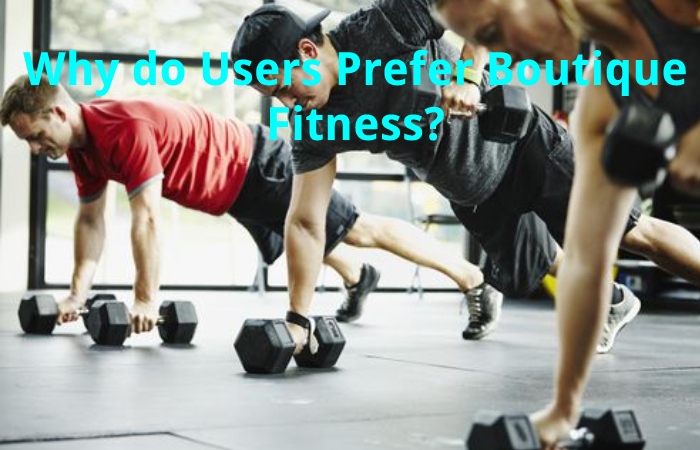Table of Contents
Boutique Fitness
A boutique fitness studio is a minor gym; Boutique fitness studios have minimal spots. The trendy ones have long wait-for lists, and reservations are typically required. With such limited availability, unlike regular fitness centres, strict attendance rules exist. As a result, many boutique fitness studios need cancellation or no-show fees. This motivates the listed to attend the classes, generally between 800 and 3500 square feet, focusing on a more community-like group exercise in one or two specific fitness areas. Some famous studios include SoulCycle, Peloton, Orange Theory, Barry’s Bootcamp, CorePower Yoga, and Class Pass.
What is Boutique Fitness?
The name of this type of gym is associated with the world of fashion, where a boutique differs from conventional stores by being personalized. In the same way, fitness boutiques are gyms that do not offer all kinds of training but concentrate on just one. Few boutique gyms focus on more than one workout as their commercial strategy is segmentation. For this reason, everything in them is dedicated to a particular discipline. Users receive classes in small groups compared to standard gyms, so the treatment is individualized. The experience of training with people with the same tastes added to this. Group training is a source of extrinsic motivation for gym users. With this, their results are better than those in a typical fitness centre.
Characteristics of Boutique Fitness
Boutique Fitness differs from other centres in different aspects related to the mechanics of training and the structure of the gym. Here are some of the features of a boutique fitness studio:
The Size of the Gym
Unlike the big gyms in the boutiques, the space is reduced, varying between 200 and 600 square meters. However, this is not a problem for the development of activities since the teams are considerably reduced by focusing on one or two disciplines.
This is why the spaces where classes are taught are not large rooms like in conventional gyms. In the same way, in these centres, only scheduled classes are usually taught. They do not have a variety of spaces that complement the gym, such as a physiotherapy spa or some other. This was the rule at least a few years ago as centres have implemented cafeterias to enjoy after training.
The Duration of the Sessions
Another outstanding feature of fitness boutiques is the short classes. A class in a gym of this type does not usually exceed an hour. In this aspect, it differentiated from the other fitness centres that have an average of two hours of training. Boutiques allow their users to generate results without spending too much time training. This is partly due to their training methodology based mainly on HIIT exercises or high-intensity training.
Personalized Training
The activities in the fitness boutiques are designed for a maximum of 20 or 30 people per session. With this methodology, the trainers closely follow each member in the class’s performance. This way, gym members make sure to perform each exercise correctly. They also adapt to the level of each new user by integrating them into a group with the same capacity. After that, users will maintain the same rate of progress in training with the help of the coaches.
The Price of the Sessions
The public targeted by boutique gyms has greater purchasing power than low-cost users. This is due to the speciality of the centre, the special machinery, and the personalized classes. However, the price of the boutiques is not as high as that of the large sports centre chains that dominate the market.
In this case, members prefer to pay more than a regular centre to obtain an experience beyond the machines’ use. The treatment of the staff, the quick results, and the fact of living in a fitness community is what lead users to opt for fitness boutiques.
Center Decoration
The atmosphere of these sports centres seeks to draw customers’ attention with decoration that is out of the ordinary. This turns the gym into a different place. For this, they allocate part of their budget to the architecture of the site that is most preferred. Avant grade is possible. Consequently, they create a representative identity.
For example, some include disco decorations to target a young audience. The association of colors and lights makes fitness boutiques stand out for their visual impact.
Why do Users Prefer Boutique Fitness?

Fitness boutiques and their opinions about them reveal an apparent factor determining user attendance at these gyms: the experience. In boutique fitness centres, members obtain knowledge beyond training, differentiating them from other gyms. At this point, users clearly say that in these centres, they feel that exercising is different.
This concept of a specialized gym encourages people to pay more than a low cost to obtain a whole range of training related to their discipline. This is why many boutique classes like CrossFit Yoga Indoor Cycling, weightlifting, and MMA exist. Users want to soak up knowledge, so they opt for the speciality.
This model causes its most significant impact on the millennial population that seeks to differentiate itself from others. They also influenced by the energy of this type of establishment, which is led by young people who seek to entertain their members. Classes to the rhythm of music surrounded by a group are more fun than performing an isolated routine with headphones.
What are Boutique Fitness Studios?
Boutique fitness studios specify a specific form of fitness for group exercise and fitness classes. Examples of boutique fitness workshops are SoulCycle, Pure Barre, and iLoveKickboxing. They appeal to those highly involved in refining their fitness level and staying consistent with their fitness goals.
Boutique studios nurture a sense of community around a style of exercise. These workshops are not open to the individual to come and work out in a gym location. These workshops only host group classes and community fitness experiences. Rendering to a study by Les Mills, 63% of persons attend these studios because of the relations they form with their peers. They make knowledge that makes fitness challenging and stimulating enough to retain the clients it attracts.
What is a Boutique Fitness or Boutique Gym?
When talking about the term boutique in general, reference is made to exclusivity; it specifies that the service or offer represents a high level of customer-oriented customization. In the same way, it happens with Boutique Gyms, an innovative business that, as we mentioned before, will be more personalized than a regular gym.
And by personalization, we mean everything (lockers, towels, merchandising, emails, calls, and other actions on behalf of the specific member) so that the focus of the entire service revolves around what the client wants, and not only in terms of physical activities but also in the different recruitment and loyalty activities.
Why are Boutique Gyms an Innovative Business Concept?
Today boutique gyms are considered in the fitness sector as an innovative business concept because it is a business model with high growth potential. In countries like the United States, it has been developing for many years, with a high level of acceptance.
It should also note that the excellent proximity capacity of these companies and the ability to reach the customer through different specialized and mutually exclusive activities leads to a different position in the market.
Advantages and Disadvantages of Boutique Fitness

These places bases on unique premises to find their place in the market, making their differential and competitive advantages reach their potential partners. In this sense, the classes are well-studied so that clients can progress and achieve their goals. In addition, they rely on the latest materials and technology to further enrich the training and improve the customer experience.
Here we specify some of these:
Advantage
- Fully specialized classes
- Individual and exclusive treatment
- Less m2 needed
- Less strength and cardiovascular machinery
- Use of functional materials
- The collective activities not massifies
- High technical quality service.
Disadvantages
- Lower partner ratio
- Very high teacher dependency
- Increased spending on salaries
- We must go through a phase of educating the population
- Risk of losing differentiation
- Take care of the progressiveness of the model so as not to “burn it out.”
Conclusion
The fitness sector has always been in continuous change, transformation and adaptation. As time goes by, the users are not the same, the reasons for keeping fit are not the same, and sports or fitness centers must adapt to these changing needs and the newest tools and methods. Therefore, personal trainers implement this in their classes.
